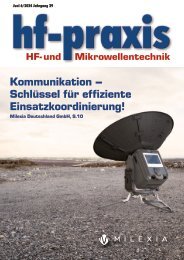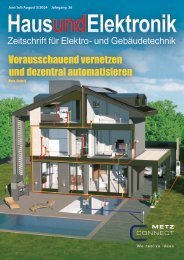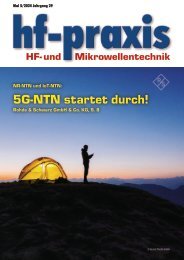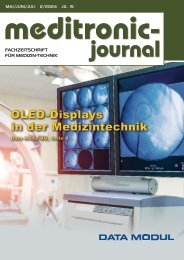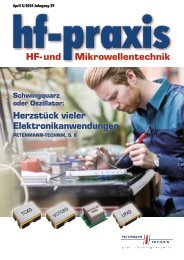7-2019
Fachzeitschrift für Hochfrequenz- und Mikrowellentechnik
Fachzeitschrift für Hochfrequenz- und Mikrowellentechnik
Erfolgreiche ePaper selbst erstellen
Machen Sie aus Ihren PDF Publikationen ein blätterbares Flipbook mit unserer einzigartigen Google optimierten e-Paper Software.
RF & Wireless<br />
Figure 20: Simulation results of the quadplexer for a) reflection loss b) insertion loss.<br />
step was to design the layout of<br />
the circuit for manufacturing. In<br />
order to eliminate crosstalk of the<br />
adjacent channels, the transmission<br />
lines to the ports were separated<br />
as much as possible. It was<br />
also important to consider that<br />
the stepped impedance resonator<br />
could affect the resonance frequency.<br />
To prevent unintended<br />
resonance, the resonators were<br />
carefully placed.<br />
Measurements were performed<br />
with a Rohde & Schwarz FSH8<br />
Figure 21: Simulation results of the EM simulation for in-band and cross-band<br />
isolation.<br />
vector network analyzer. Figure<br />
22 shows the measurement<br />
results for insertion loss. It can<br />
be seen that there is discontinuity<br />
at the B7 Tx band, where the<br />
lowest performance was achieved<br />
at around 2.66 GHz.<br />
The final measurement was the<br />
isolation loss of the quadplexer.<br />
which is shown in Figure<br />
23. Cross-band isolation is at a<br />
satisfactory level, but in-band<br />
isolation is worse than the EM<br />
simulation result. In-band isolation<br />
is around -20 dB, where<br />
expected isolation is around<br />
-30 dB.<br />
Conclusion<br />
This application example has<br />
described the design of a quadplexer<br />
with high isolation losses<br />
between output ports. The device<br />
slightly under performed compared<br />
to simulation results, however,<br />
there are several contributing<br />
factors, including that the<br />
quality of the machinery system<br />
was low for producing high-quality<br />
RF circuits and that the soldering<br />
process in manufacturing<br />
is challenging. The reflection<br />
parameters are not good enough<br />
for both business and academic<br />
applications, however, if the<br />
diplexer is well designed the<br />
insertion loss of the quadplexer<br />
should not be affected compared<br />
to insertion losses of the BAW<br />
duplexers, individually. Because<br />
CA technology is used generally<br />
in mobile devices, a quadplexer<br />
or multiplexer design must be<br />
as small as possible. Another<br />
improvement point for a better<br />
quadplexer would be to use a<br />
high Q resonator rather than a<br />
stepped-impedance resonator,<br />
which would be useful in terms<br />
of selectivity and shrinking<br />
dimensions. ◄<br />
Figure 22: Simulation results for insertion loss of the quadplexer.<br />
Figure 23: Measurement results for isolation of the quadplexer.<br />
hf-praxis 7/<strong>2019</strong> 59









